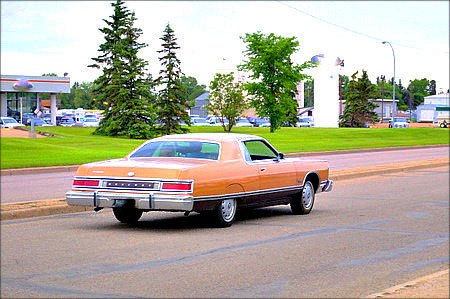Why Every Car Guy Needs To Pilot A Giant Old School Land Yacht Barge
These days the big kids on the block are giant pickup trucks and luxury model sport utility vehicles. A bygone era in Detroit featured giant cars with giant engines and painfully small mpg ratings.
The movement toward big and beautiful really caught fire in the late 50s when the Big Three fought a size-really-matters battle with their high end luxury models.
Purists would argue that high end pre-war cars were pioneers in the giant automobile craze, and they would be right. But the big car era became pretty main-stream until the 1973 oil embargo swung the size-matters pendulum the other way.
Even then, the big car managed to limp into the eighties as a regular production vehicle for the large and tall customer, or the senior who had yet to discover bungalow-sized diesel-pusher motorhomes.
But the experience behind the wheel of an old-school land yacht should be mandatory for every car guy-young and old. If these babies were good enough for the underworld broken noses chasing Jimmy Rockford around the greater LA region, then they are good enough for the average Joe in today’s collector car world.
The biggest drawback for today’s younger drivers is the sheer size of the beasts. They like a car that can dance through traffic while they text, watch a movie, check out the latest tattoo creeping closer to their face, and listen to an MP3 file. They are unfamiliar with the idea of a wallowing ride and 8 tracks that work at least 65 percent of the time. And massive weight coupled with drum brakes that made drivers pay strict attention to the road.
The big boys were really made for the open road where living room comfortable seats made the front seat seem like a plush couch with a windshield and steering wheel in front of it.
It made for a great driving experience – one that should be shared by every driver at some point in life. Just make sure to tee up a Doobie Brothers 8 track with ‘Rockin down the Highway’ on it for the journey. Then it will make complete sense.
For more of Jim Sutherland’s work go to mystarcollectorcar.com
Latest Car Reviews
Read moreLatest Product Reviews
Read moreRecent Comments
- Jeff Self driving cars are not ready for prime time.
- Lichtronamo Watch as the non-us based automakers shift more production to Mexico in the future.
- 28-Cars-Later " Electrek recently dug around in Tesla’s online parts catalog and found that the windshield costs a whopping $1,900 to replace.To be fair, that’s around what a Mercedes S-Class or Rivian windshield costs, but the Tesla’s glass is unique because of its shape. It’s also worth noting that most insurance plans have glass replacement options that can make the repair a low- or zero-cost issue. "Now I understand why my insurance is so high despite no claims for years and about 7,500 annual miles between three cars.
- AMcA My theory is that that when the Big 3 gave away the store to the UAW in the last contract, there was a side deal in which the UAW promised to go after the non-organized transplant plants. Even the UAW understands that if the wage differential gets too high it's gonna kill the golden goose.
- MKizzy Why else does range matter? Because in the EV advocate's dream scenario of a post-ICE future, the average multi-car household will find itself with more EVs in their garages and driveways than places to plug them in or the capacity to charge then all at once without significant electrical upgrades. Unless each vehicle has enough range to allow for multiple days without plugging in, fighting over charging access in multi-EV households will be right up there with finances for causes of domestic strife.



































Comments
Join the conversation
"The big boys were really made for the open road where living room comfortable seats made the front seat seem like a plush couch with a windshield and steering wheel in front of it." I wonder if, in addition to changing tastes* and an interest in fuel economy (though gas is still pretty cheap), the open road has lost some of its mystique. Interstates have brought urban buildup into the countryside, and most highway trips are punctuated by segments of city freeway where a nimble car is an asset. Unless you do your traveling at 2AM, you're likely to get caught in heavy traffic. Even then, tight turns on ramps and flyovers are more common these days... Even some midsizers don't like being taken around a cloverleaf above the speed on the yellow advisory speed signs.
In college I had a 1967 Fury II. It was a massive two door coupe, with a full six foot back seat, and six foot bench in front as well. 383 "supercommando" V8. Big Brakes. It had a good two inches of slippage between the steering wheel and the front contact patches. It was a time warp car, with only a rip on the seat as "wear". The prior owner bought it, waxed it and passed-on. The perfect old-man car buy. If you could get past the 6-10 mpg, it started and ran like hell, easily overcoming the "by the pound" steel used. Momentum, once gained was to be managed...something you don't learn as easily in, say, some tiny import. Turns were planned in Advance. The only "car" I've recently driven that was anything like this old school road hugging weight car was a Ram 1500 crew cab pickup. I should have de-badged the car because it was stolen one evening from Boston streets...and the only reason anyone would take it would be for that 383.